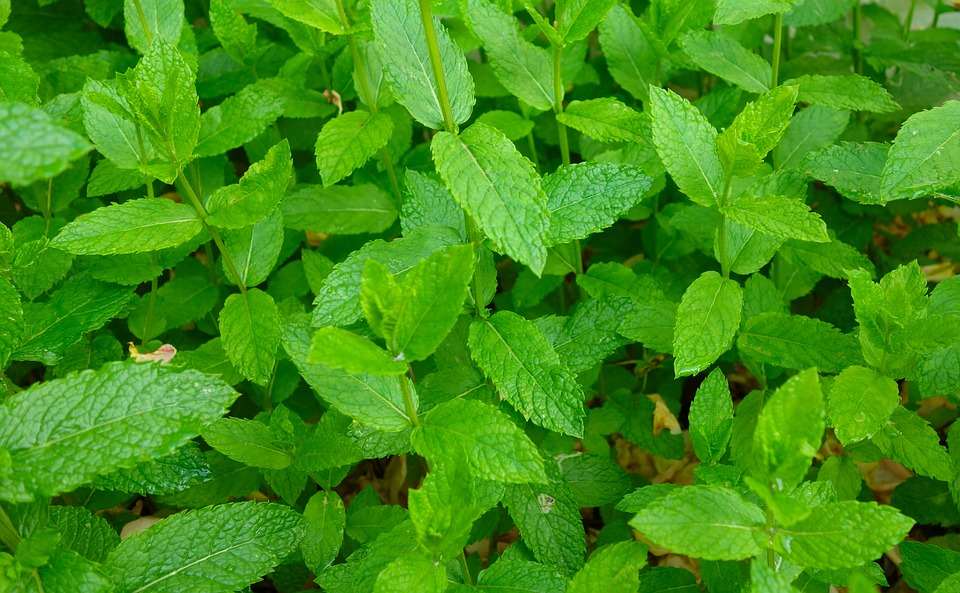Peppermint
Peppermint
An oil for those tired, scattered, stuffy, + sore times
It’s almost winter and with winter comes colder weather, the holidays and an endless number of to do’s on a deadline. As I sink into my chair after a long day of running around, I feel the start of a tension headache and notice that my shoulders feel like they’re in knots. Enter Peppermint, an uplifting oil that is my go to headache tamer, energizer, focuser, sinus clearer, tummy soother, and banisher of pain and muscle tension.
Peppermint’s botanical name is Mentha x piperita and is considered a hybrid mint, which is just a fancy way of saying that it’s a cross between spearmint and watermint. This beautiful aromatic is native to the Middle East and Europe but is now being grown in many different parts of the world including the US. The vivid dark green leaves and purple flowers make one of the nicer aromatics to grow in your medicinal garden. Just remember that this perennial beauty is best grown in a container as it spreads by rhizomes and has the potential to overtake your garden (trust me on this one).
The clear to pale yellow essential oil is obtained from the steam distillation of peppermint’s leaves and flowers. If you ever want to try a home distillation, aim to harvest the peppermint when 10-20% of the plant is flowering as both the essential oil yield and menthol is increased. [1]
This delicious candy cane smelling oil is indispensable in my first aid kit and ranks up there with lavender in it’s versatility for handling all manner of mind, body, and emotional complaints. Whereas I see lavender as having a grandmother energy, Peppermint is a strong (and at times brash) workhorse. It’s bold scent brings me into the present moment faster than any other oil, making it one of my favorites for focusing the mind and uplifting my spirit when I’m feeling scattered and tired. And it’s ability to warm and ease tension, be it a headache or just tight shoulders is indispensable, particularly this time of year.
CHEMISTRY:
Looking at the chemistry of an essential oil can tell us about it’s safety, toxicity and in some cases it’s therapeutic possibilities.
Peppermint is very high in the monoterpene alcohol, Menthol (39-49% of the oil) and has a moderate amount of the non-neurotoxic ketone Menthone (8-31%) [2]. The menthol is the constituent that gives Peppermint it’s characteristic fresh and minty scent. Menthol is considered analgesic meaning it reduces pain and it’s interesting to note that when used topically at < 2% dilution has a cooling effect and when used at >5% has a rubifacient or warming effect [3].
SAFETY:
Contraindications: This oil should not be used in those with G6PD deficiency or Cardiac Fibrillation
Caution with Kids: Best avoided altogether with children under 3 years of age (use spearmint instead) and can be diffused or used topically up to 0.5% in children 3-6 years (4 drops in 1 oz of carrier oil) [4]
RESEARCH:
Research on Peppermint essential oil has looked at it’s benefit in the following areas:
Analgesic (Tension headache) [5]
Chronic pruritis [6]
Antispasmodic (IBS) [7]
Nausea and vomiting [8]
Alertness + Mood [9]
Memory [10]
Sinusitis [11]
USE
Historically and in current aromatherapy practice Peppermint is used for:
Mind + Emotions: Great for fatigue or feeling scattered. Used for energizing, focusing, and refreshing
Body: Use for headaches, muscular aches and pain, GI bloating and pain, congested sinuses, hot flashes and nausea and vomiting
Skin: A refreshing skin tonic when used in low dilutions. Helpful for itchy skin conditions
INSIDER TIPS
Remember that you want your supplier to provide the following information about their essential oils…
Common Name: Peppermint
Latin Name: Mentha x piperita
Country of Origin: Most common areas include United States, India, China, Hungary, France, England
How was it grown: Organically, ethically, wild-harvested, or conventionally
Extraction: Steam distillation of leaves and/or leaves and flower buds
RECIPES
While Peppermint has a variety of uses in aromatherapy, I use it most for it’s energizing, focusing, clearing and pain relieving effects. Think tired, scattered, stuffy + sore when you think about how peppermint essential oil might help you.
For those that don’t want to make their own peppermint recipes visit our shop to try our Awake Sugar Scrub and Focus blends.
TENSION TAMER OIL
This is my go to headache remedy. I use it at the first sign of tension headaches or as a spot treatment when I am feeling tension in my back or shoulders Carry it in your purse or backpack and you will be everyone’s new favorite person.
Supplies:
1/2 oz glass bottle or rollerball bottle
35 drops peppermint essential oil
10 drops lavender essential oil
Organic carrier oil (I prefer jojoba)
Step 1: Fill the glass bottle or rollerball bottle 3/4 full with organic carrier oil
Step 2: Add 35 drops peppermint essential oil and 10 drops lavender essential oil to the bottle
Step 3: Mix and use at the first signs of tension. Remember that the peppermint in this blend will have a warming effect
AWAKE SUGAR SCRUB
I developed this sugar scrub a few months ago and it’s added a whole new element to my morning routine. I’m amazed at how something so simple has become indispensable. Who knew that a short scrub would help me to come alive even before my first cup of chai.
Supplies:
1 cup organic sugar
1/4-1/2 cup organic carrier oil (I use lavender infused sunflower oil)
6 drops peppermint essential oil
6 drops rosemary essential oil
3 drops eucalyptus essential oil
3-5 drops mixed tocopherol (vitamin E) drops
8-9 oz jar
Step 1: Add 6 drops peppermint, 6 drops rosemary, 3 drops eucalyptus, 3 drops mixed tocopherols to your carrier oil and mix together
Step 2: Slowly pour the oil mixture over the 1 cup sugar mixing as you go. Mix until your reached your desired consistency. This will be the full 1/2 cup for some people and less for those who want a less oily feel
Step 3: Store in a clean 8-9 oz jar with lid and enjoy in the shower or bath
SINUS STEAM
A clearing steam for those times when you can hardly breathe through your nose
Supplies
4 cups steaming water in a bowl
1 drop Peppermint essential oil
1 drop Eucalyptus essential oil
1 towel
Step 1: Add 1 drop peppermint and 1 drop Eucalyptus to 4 cups of steaming water
Step 2: Create a “tent” with the towel by lowering your head over the bowl and placing the towel over your head and the bowl
Step 3: Make sure to close your eyes and inhale through your nose and mouth. Do this for approximately 5 minutes
REFERENCES
White, J.G., Iskandar, S.K., & Barnes, M.F. (1987). Peppermint: effect of time of harvest on yield and quality of oil. New Zealand Journal of Experimental Agriculture. 15: 73-79.
Rhind, J.P. (2012). Essential Oils: A handbook for aromatherapy practice (2nd ed.). Philadelphia, PA: Singing Dragon. and Tisserand, R. & Young, R. (2014). Essential Oil Safety: A guide for Health Care Professionals (2nd Ed.) Philidelphia, PA: Elselvier.
Harris, B. (2004). The role of menthol, methyl salicylate and eugenol in pain relief. International Journal of Clinical Aromatherapy. 1(1): 16-23.
Tisserand, R. & Young, R. (2014). Essential Oil Safety: A guide for Health Care Professionals (2nd Ed.) Philidelphia, PA: Elselvier.
Gobel, H. et al. (2016). Peppermint oil in the treatment of tension-type headache. Der Schmerz. 30(3): 295-310.
Elsaie, L.T., et al. (2016). Effectiveness of topical peppermint oil on symptomatic treatment of chronic pruritus. Clinical, Cosmetic and Investigational Dermatology. 9: 333–338
Curro, D. et al. (2017). Probiotics, fibre and herbal medicinal products for functional and inflammatory bowel disorders. British Journal of Pharmacology. 174(11):1426-1449.
Tayarani-Najaran, Z. et al. (2013). Antiemetic activity of volatile oil from Mentha spicata and Mentha × piperita in chemotherapy-induced nausea and vomiting. ECancer Medical Science. 7:290. doi: [10.3332/ecancer.2013.290]
Mentha- Peppermint Oil. Herbal Reference. Accessed on December 13, 2018 from: https://herbalref.com/mentha-peppermint-oil-menthae-piperitae-aetheroleum/
Moss, M., Hewitt, S., Moss, L., Wesnes, K. (2008). Modulation of cognitive performance and mood by aromas of peppermint and ylang-ylang. International Journal of Neuroscience. 118(1): 59-77.
Buckle, J. (2015). Clinical aromatherapy: Essential oils in healthcare (3rd ed.). St. Louis, MO: Churchill Livingstone.

